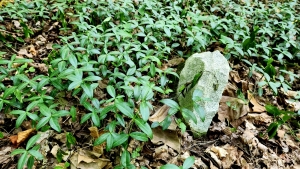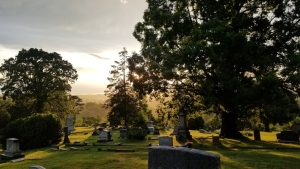GRANDVIEW, W.Va. — Trees once shaded country cemeteries in Appalachia, according to an archaeologist. As a practical matter, they were not covered in grassy lawns, which would have been challenging to maintain.
According to David Rotenizer, an archaeologist and Virginia tourism official, caretakers planted trees to shade the cemeteries and deter the growth of grass and brush. They also planted evergreen ground covers, especially periwinkle, which thrives in shady conditions.
"Old-timers had a system of managing cemeteries," he explains. "They planted periwinkle (Vinca minor) as a ground cover, along with shade trees. This kept briers and grass at bay, and the trees helped the shade-loving periwinkle thrive."
However, in recent years, the trustees for many old cemeteries have removed the shade trees, erasing the historical character and increasing the maintenance cost, which is realized most often in the price of mowing and the application of herbicides.
"New generations cut down the trees, and the periwinkle died back, and the grass and brush took over, and that's when maintenance issues begin," he said.
Now executive director of the Blacksburg-Christiansburg-Montgomery County Regional Tourism, Rotenizer says his heart still lingers in country cemeteries in the hills.
"When I was active in cemetery preservation consulting, I always recommended planting periwinkle in small cemeteries as a conservation tool. Once in strength, it will block weeds and grasses and stay green year round."
He also recommends that cemetery boards and foundations invest in traditional deciduous shade trees such as oaks and maples, which lose their leaves in winter, and in ornamental evergreens, all common in historic cemeteries and graveyards.
"Trees were introduced into cemeteries, especially the cedar," he said, the origins of which are old-world, and, like the periwinkle, the cedar was believed by some to possess supernatural properties.
"The use of periwinkle for groundcover was brought over from central Europe with early tradition being that it warded off evil spirits."
Yucca is another commonly introduced plant that can help locate cemeteries, and exotic plants can also lead cemetery hunters to find burials.
"Keep an eye out for additional planting that seems out-of-character for the area. If families of the deceased knew that the person liked an exotic plant type, it might have survived. You never know," he said.
Other traditional cemetery plants include iris, peony, phlox, and daylily.
Rotenizer adds that periwinkle can often still grow beneath the grass, waiting for a day when the shade returns. However, he says cemetery committees should proceed carefully when restoring burial grounds.
"I encourage boards and cemetery groups to not engage in projects unless they have done due diligence researching and understanding the best practices for cemetery preservation projects. It's easy to do more long-term harm than good," he says.
"Every cemetery is unique. Every cemetery is special. As such, they are non-renewable cultural resources."
In particular, he cautions against using cleaners and bleaches when cleaning headstones. "If you must clean, use water and a soft bristle brush. Water will solve 90 percent of your concerns."
Committees should also be careful to keep records, he says, and share them with historical societies and commissions.
"Document your work, and leave records with local historical groups. Too often, no one knows about the smaller plots, which can easily become lost and ultimately destroyed during development. They need to be recorded."
Rotenizer says the Association for Gravestone Studies is an ideal resource for cemetery preservation. The Preservation Alliance of West Virginia is also a critical state organization that occasionally offers training opportunities and may be aware of restoration training elsewhere.
Read Also
Sign up for a FREE copy of West Virginia Explorer Magazine in your email twice weekly. Sign me up!





